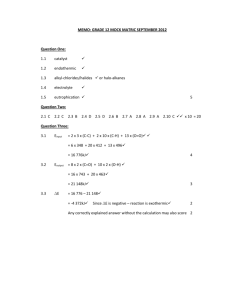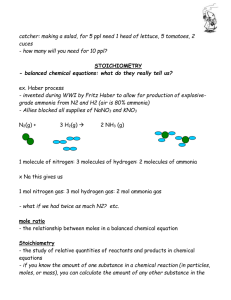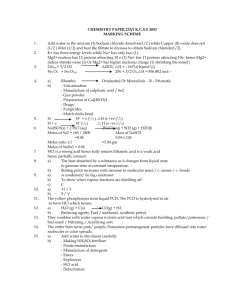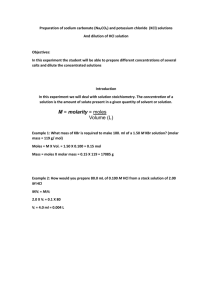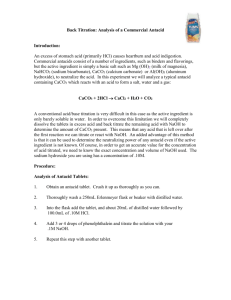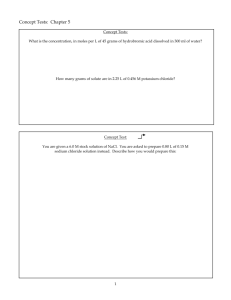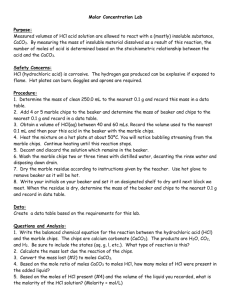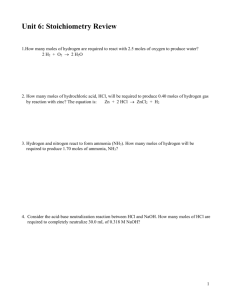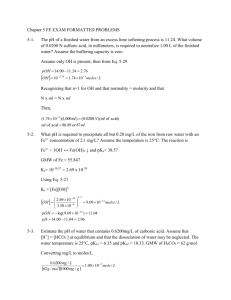chem 1 - kcse online
advertisement
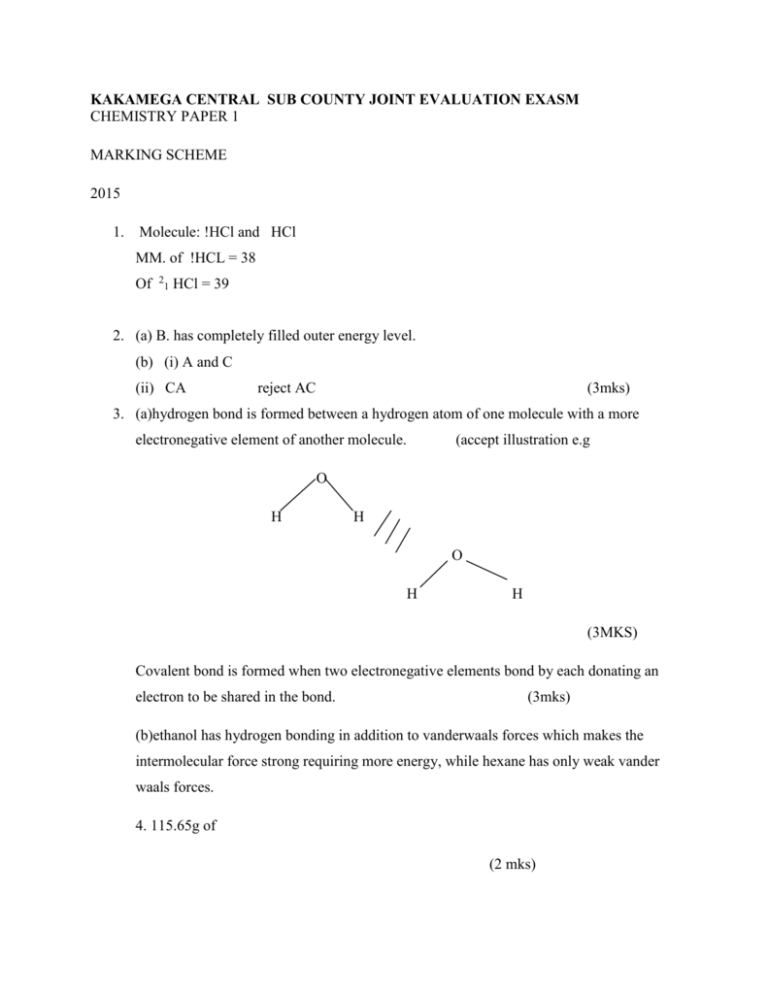
KAKAMEGA CENTRAL SUB COUNTY JOINT EVALUATION EXASM CHEMISTRY PAPER 1 MARKING SCHEME 2015 1. Molecule: !HCl and HCl MM. of !HCL = 38 Of 2 1 HCl = 39 2. (a) B. has completely filled outer energy level. (b) (i) A and C (ii) CA reject AC (3mks) 3. (a)hydrogen bond is formed between a hydrogen atom of one molecule with a more electronegative element of another molecule. (accept illustration e.g O H H O H H (3MKS) Covalent bond is formed when two electronegative elements bond by each donating an electron to be shared in the bond. (3mks) (b)ethanol has hydrogen bonding in addition to vanderwaals forces which makes the intermolecular force strong requiring more energy, while hexane has only weak vander waals forces. 4. 115.65g of (2 mks) b) Ethanol has hydrogen bonding in addition to vander waals forces which makes the intermolecular force strong requiring more energy, while hexane has only weak vander waals forces. 4. 115.65 of saturated solution contain 15.65 g of FeSO4 . 45 g of saturated solution will contain 45 x 15.65 115.65 = 6.0895g 5. (2mks) Reacting mole ratio CaCO3: HCl = 1:2 Moles of HCl = 0.2moles Moles of CaCO3 require = 0.2 x ½ = 0.1 moles M.M of CaCO3 = 40 + 12+48 = 100 Moles of CaCO3 is 15g = 15/ 100 = 0.15moles No of moles in excess = 0.15 – 0.1 = 0.05 Mass in excess = 0.05 x 100 = 5g of CaCo3 (3mks) 6. (a) Molecula mass = (C3H6O)n = 116 (12 x 3 +6 x 1 +16)n = 116 (42+16)n= 116 58n =116 N=116/58 N= 2 M.F. is C6H12O2 b) %age of C (2mks) = 12x6 x 100 116 = 72 116 x 100 = 62.069% (1mk) = 62.07% 7. a) i) - Bromoprop-1-ene ii) But-1-yne b) The brown colour of bromine watr decolourises (3mks) 8. a) G- Ammonia b) Filtration c) 2NaHCO3(s) Na2CO3(s) + CO2 + H2O (l) (3mks) Penalise for wrong or missing symbols /2mk 9. Magnesium has 2 valence electrons delocalized in its structure compared to sodium which has only 1 (2mks) 10. a) Isotopes b) c) EO2 (3mks) 11. a) Covalent bond and dative bond / dative covalent/ coordinate b) 14 electrodes c) Nitrogen in ammonia has a lone pair of electrons which it shares with the empty sub energy level f Boron to enable it have 8 electrons 12 (3mks) i) M ii) M iii) L (3mks) 13. Working diagram (3mks) Label paraffin upper layer Water lower layer 14. i) Boiling point is arrange not specific temperature ii) Determine the fraction by fractional distillation (2mks) 15. a) Solution Phenolphthalein Indicator N Distilled water Ammonium Pink hydroxide Hydrochloric acid Colourless (2mks) b) Universal indicator 16. P1V1 = P2V2 T1 V2 T1 = P1V1T2 T1P2 = 100648.5 x 0.3 x 283 = 303 x 101 325 303 x 101325 (substitution) (2mks) V2 = 0.2783dm3 17. a) T(S)+ X2+ (aq) T 2+ (aq) + X (s) (3mks) (Penalise for missing or wrong state symbols ½ ) 18. a) MgSO4(aq) +Na2CO3(aq) MgCO3(s)+NaSO4(aq) CaCl2+ Na2CO3 b) Sodium Carbonate. Ammonia Solution. 19.(i) water level in the gas jar will rise Size of phosphorus will reduce Water level in the trough will reduce White fumes as phosphorus smouldes. (any two correct ½ mk each) (3mks) (ii) P4+5O2(g) (iii) Magnesium react with both oxygen and nitrogen. Hence greater reduction in volume. 20. (a) endothermic reaction is where heat energy is absorbed from the environment resulting in fall in temperature. (1mk) Exortermic reaction is where heat energy is evolved to the environment resulting in rise in temperature (b) CH4 (g) 2O2(g) CO2(g) + 2H2O(l) Bonds broken 4-H Bond formed 2 0=0 2 C =0 4 H -0 DH = (4x413+2x497) – (2x 804 + 4x46) (1652 + 994) – (1608 + 1856) = - 118KJ/mol 21.(a) The dry wood turned black and bubbles of colourless gas produced . conc. Sulphuric acid dehydrated to wood. (1mk) (b) Acidified K2Cr2O4(aq) changed from orange to green. Conc. H2SO4 acid is reduced to SO2(g) which reduced K2Cr2O4/ to green Chromate (III) Sulphate. (2mks) 22. (a) The black mass turned red/red brown (b) CuO(s) + C(s) →Cu(s) +CO(g) (c) Fuel/Reducing agent in extraction of metals. (3mks) 23. (a)water (b)2C2H6(g) + 7O2(g) → 4CO2(g) + 6H2O(l) c) Some CO2(g) produced dissolved in it making it weakly acidic with pH below 24. Na2CO(s) 2HCl(aq) 2NaCl(aq) + CO2(g) + H2O(l) RFM of NaCO3 = 2 x 23 +12 +48 = 106 (3mks) Moles of NaCO3 = 5.3 / 106 = 0.05moles Reacting mole ratio 1:2 :- Moles of HCl = 0.05 x 2 = 0.10 moles Volume of HCl = 0.1 x1000 0.5 = 200cm3 of HCl 25. (3mks) a) To allow for steady flow of ammonia gas to be liberated b) Yellow flame c) 4NH3(g) + 5O2(g) 4NO(g) + 6H2O(l) (3mks) 26. a) Halogens b) x and Y c ) 3Z2(l) + 2Fe(s) 2FeZ3 (s) or 3Br2(l) +2Fe(s) 2FeBr3(s) (3mks) 27. a) R – Hydrogen b) Product Iron(II) Chloride Equation Fe(s) + 2HCl(g) FeCl2(s) + H2(g) (3mks) 28. a) Sulphur b) To strengthen it / make it tough (2mks) 29. a) Existence of an element in more than one form under same condition b) Sulphur, carbor, phosphorus any two correct (3mks)
